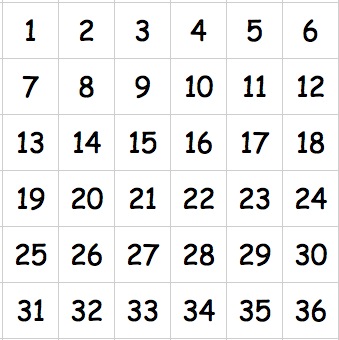Or search by topic
Number and algebra
Geometry and measure
Probability and statistics
Working mathematically
Advanced mathematics
For younger learners
So It's Times!



- Problem
- Getting Started
- Student Solutions
- Teachers' Resources
So It's Times!
This activity has been particularly created for the most able. (The pupils that you come across in many classrooms just once every few years.)
On the table in front of you is a grid like this:-

Why do this problem?
This problem is designed to challenge pupils both in number and spatial skills. It provides an opportunity for pupils to consider the properties of multiplication and to test their ideas.
Possible approach
If necessary before approaching the six by six array, present two sheets with a four by four array. Try not to go through it completely, but just try a couple of multiplications and then turn the top sheet over (or around, or both) and see what a few of the multiplications would be then.
The six by six grid can be printed out for pupils to use, and pupils might want to use tracing paper in order to create a see-through version of the grid. The challenge will need to be explained very clearly so as to prevent a lot of unnecessary calculations being made.
Key questions
What else could you explore?
Possible support
Pupils could explore a smaller grid, such as a three by three grid or a two by two grid. The restriction about not being allowed to calculate and add every multiplication can be relaxed on a smaller grid, and pupils can calculate which arrangement would give the highest and the lowest total. Pupils should then be encouraged to explain why they think this has happened, and whether or not they think the solution would be similar with a larger grid size.
Possible extension
Children could have a go at It's Times Again, which encourages children to explore how the problem changes if the numbers are no longer necessarily consecutive.
You may also like
Exploring Wild & Wonderful Number Patterns
EWWNP means Exploring Wild and Wonderful Number Patterns Created by Yourself! Investigate what happens if we create number patterns using some simple rules.
Sending Cards
This challenge asks you to investigate the total number of cards that would be sent if four children send one to all three others. How many would be sent if there were five children? Six?
Dice and Spinner Numbers
If you had any number of ordinary dice, what are the possible ways of making their totals 6? What would the product of the dice be each time?

